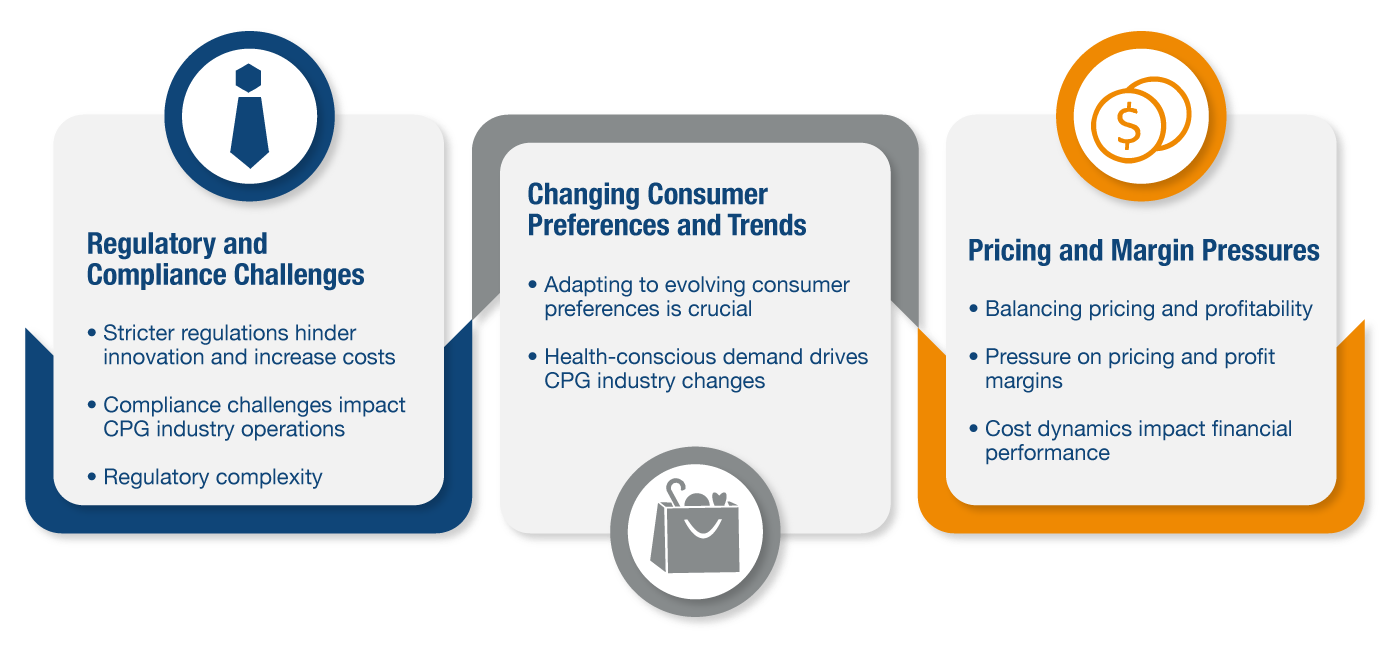Share
The Consumer Packaged Goods Market: Exploring Size, Scope, and Global Significance
Private equity firms are increasingly recognizing the growth and profitability potential in the Consumer Packaged Goods (CPG) market, leading to their increased engagement in this sector. Spanning a wide array of products, including food, beverages, personal care items, and household goods, the global CPG market boasts a staggering worth of over $2T in 2022.
Projections indicate a CAGR of 2.9% from 2022 to 2030. The CPG market's significance surpasses its economic value as it supplies essential products used by consumers daily. It also plays a pivotal role in job creation and contributes to economic growth—exemplified by the employment of over 2 million individuals and a GDP contribution of over $2T in the U.S. alone.
The CPG industry is characterized by intense competition. In order to maintain their market position, companies strive to innovate, differentiate their offering, and adapt to changing consumer preferences.
CPG Industry: Market Tailwinds

CPG Industry: Market Headwinds

The Market Implications of Covid and Geopolitical Risks
Covid caused significant shifts in consumer demand, supply chain disruptions, accelerated e-commerce growth, and an increased focus on health and safety in the CPG market. Essential items experienced a surge in demand while non-essential categories declined. Supply chains faced challenges due to restrictions and transportation disruptions.
E-commerce witnessed substantial growth as consumers turned to online shopping. Health, hygiene, and safety became top priorities— driving increased demand for products with health benefits, immunity-boosting properties, and sustainable packaging.
Recently, current geopolitical conflicts have brought about several impacts on the CPG market, including significant trade and supply chain disruptions. This has led to challenges in the movement of goods, increased costs, and delays in the supply of CPG products. Geopolitical uncertainty affects investor confidence and decision-making, potentially impacting foreign investments, partnerships, and expansion strategies in the CPG market.
Additionally, consumer sentiment can be influenced by geopolitical conflicts, causing shifts in purchasing behavior and preferences. Consumers may display patriotic sentiments, preferring locally produced goods or avoiding products associated with specific regions or countries involved in the conflict.
Investment Trends in CPG Industry
Private equity investments in the CPG industry have been on the rise in recent years due to the increasing size and growth potential of the CPG industry−the attractive valuations of many CPG companies, and the increasing expertise of private equity firms in the CPG sector. Some of the major recent deals are:
- In February 2023, Apollo Global Management acquired Krave Jerky, a maker of beef jerky. The deal was valued at $200M.
- In March 2023, TPG Growth acquired RXBar, a maker of protein bars. The deal was valued at $600M.
Overall, the CPG sector is an attractive investment for private equity. Firms are investing in CPG companies for a variety of reasons, including the size and stability of the market, the relative ease of management, and the opportunities for growth.
Emerging and Future Trends for the CPG Industry
The CPG industry is poised to experience several key tailwinds in the coming years. Some of the future trends that are expected to shape the industry include:
Sources
- “Growth in an uncertain economy: three key considerations for CPG companies.” PWC, May 2023.
- “Global Consumer Packaged Goods (CPG) Market Size By Type (Food and Beverage, Personal Care and Cosmetics), By Distribution Channel (Off-line, Online), By Geographic Scope And Forecast.” Verified Market Research, Sep. 2022.
- “More than half of all CPG companies on track to grow below the market by 2027.” KEARNEY, Jun. 2022.
- “Global Consumer Packaged Goods (CPG) Market [2023-2030] | Expected to Reach USD 2418700 Million and Growth Rate is 3.1%.” Market Watch, Apr. 2023.
- “Consumer Packaged Goods (CPG) Market Worth USD 2502710 million by 2028 | Share, Rapid Growth, Technologies, Development Strategy, Business Prospect, Development Strategy | Key Players, Top Countries, Types, and Applications.” Globe Newswire, Apr. 2022.
- “COVID-19’s impact on demand and costs in the CPG industry.” McKinsey, Mar. 2022.
- “COVID-19: 10 consumer trends impacting CPGs.” Accenture, Jun. 2020.
- “Impact of Russia-Ukraine Conflict in Consumer Goods.” Global Data, May 2022.
- “RUSSIA-UKRAINE WAR: GLOBAL IMPACT ON LOGISTICS.” GEP, Sep. 2022.
- “Economic headwinds: Consumer products, Inflation and shifting buying habits hit businesses.” RSM, Sep. 2022.
- “Here’s how CPGs are bracing for more volatility in 2023.” Food Dive, Jan. 2023.
- “How private equity investment in CPG brands can boost value.” E&Y, Mar. 2023.
- “PE deals on CPG industry.” Pitchbook: Stax analysis, May 2023.
- “9 Important CPG Industry Trends 2023-2026.” Exploding Topics, Jan. 2023
- “How AI in CPG Gets Products to Market Faster.” Starmind, May 2023.
- “CPG industry contributes $2 trillion to U.S. GDP.” Institute of Food Technologies, Aug. 2019.






